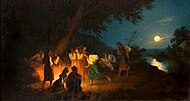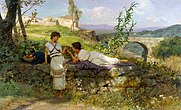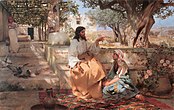Henryk Siemiradzki
Henryk Siemiradzki (born October 12, jul. / 24. October 1843 greg. In Nowobelgorod in Kharkiv ; † 23. August 1902 in Strzałków in Czestochowa ) was a Polish painter . He is considered a representative of salon painting and academic art .
Life
Siemiradzki was born in the small village of Novobelgorod (today the Pechenihy urban-type settlement 50 km east of Kharkiv). When he was four years old, his family moved to Kharkiv.
In 1860, at the request of his father, Siemiradzki studied at the physics and mathematics faculty of the University of Kharkiv. In 1864 he completed his studies with a thesis on the subject of "On the instincts of insects". During his student days Siemiradzki collected numerous butterflies, which interested him until the end of his life. During his studies he kept in contact with Dmytro Bezperchy and took lessons from him.
He continued his education at the Academy in Petersburg , went to France and Germany in 1870, where he stayed in Munich in 1871 and was a student of Karl Theodor von Pilotys , and settled in Rome in 1872 .
In 1870 the artist came to Kharkiv for the last time to sell the family property, including some paintings that are now exhibited in the Kharkiv City Art Museum.
He chose the motifs for his historical and genre images preferably from ancient Greece and Rome , and occasionally also from the New Testament . He tried to combine the highest luster and richness of color with exact reproduction of the material. He mostly strived for a sensual effect, which he tried to increase through the play of sunlight.
He did not shrink from the voluptuous and dreadful, for which his main work, The Living Torches of Nero (1876, cremation of Christian martyrs before Nero and his court) is characteristic. Theodor Fontane has one of the protagonists of his novel Die Poggenpuhls describe this picture as follows:
“[...] that was a picture, as big as the canvas of a Spree barge or probably even bigger, and on the right side, yes, there was what the scholars call the 'torches of Nero' and a a few were already on fire and the others were just infected. And what do you think [...] what these torches actually were? They were Christians, Christians wrapped in pitchcloths, and looked like mummies or big babies, and this Nero, the organizer of all this horror, was lying very comfortably on a golden wagon, and two gold-colored lions in front of it and the third lion lay next to it him, and he scratched his mane as if it were a poodle. "
Of his other works we should mention: Alexander's trust in his doctor Philip (1870), Christ and the Adulteress (1871), The Woman or the Vase and The Begging Shipwrecked Man (two genre pictures from ancient Roman life, 1879), The Sword Dance (1880 ), Christ with Mary and Martha (1886), glow worms, lovers in Pompeii, and Phryne (1888).
Siemiradzki's monumental painting
literature
- Siemiradzki, Henryk . In: Hans Vollmer (Hrsg.): General lexicon of fine artists from antiquity to the present . Founded by Ulrich Thieme and Felix Becker . tape 31 : Siemering – Stephens . EA Seemann, Leipzig 1937, p. 1 .
- Heinrich Hart : burial of a Russian chief. In: Lars-Broder Keil (ed.): Mongol hordes in the zoological garden. Berlin letters (= assembly pocket books 2084). Structure of the Taschenbuch-Verlag, Berlin 2005, ISBN 3-7466-2084-8 , pp. 143–150.
Web links
Individual evidence
- ^ Theodor Fontane: Novels and short stories in eight volumes. Volume 7: Effi Briest. The Poggenpuhls. Mathilde Möhring. Aufbau Verlag, Berlin / Weimar 1973, p. 372 ( zeno.org )
| personal data | |
|---|---|
| SURNAME | Siemiradzki, Henryk |
| BRIEF DESCRIPTION | Polish painter |
| DATE OF BIRTH | October 24, 1843 |
| PLACE OF BIRTH | Novobelgorod near Kharkiv |
| DATE OF DEATH | August 23, 1902 |
| Place of death | Strzałków near Czestochowa |








